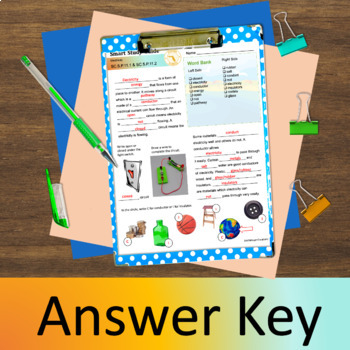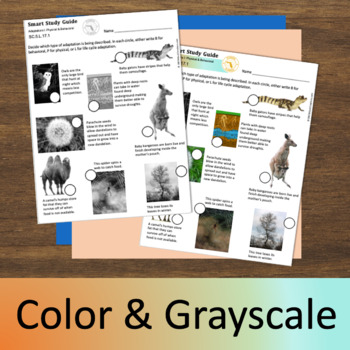Florida 5th Grade Interactive Study Guide - Complete Science Bundle
- Zip
- Easel Activity
What educators are saying
Products in this Bundle (20)
showing 1-5 of 20 products
Also included in
- Make your life easier with these 100% Florida aligned science activities for 5th grade. Includes interactive notebooks, student choice boards, interactive study guides, reading passages and activities, games, data tracking, fair game review, and nature of science CSI. You no longer have to dissectPrice $160.13Original Price $230.75Save $70.62
Description
Print and go interactive study guide covers your Florida science standards for 5th grade. This resources also works well for ELLs and struggling science students for notetaking purposes. Cloze passages and interactive visuals help students review material in preparation for unit tests of the science FSSA.
This Resource is Great for:
- Test Review
- At Home Learning, Homework
- Skill Practice or Review
- English Language Learners
- Struggling Science Students
Each Activity Includes:
- 1 or 2 student pages (grayscale and color)
- Answer key
Next Generation Sunshine State Standards (NGSSS) Science Statewide Academic Standards (SAS) (B.E.S.T):
- Types of Forces
- SC.5.P.13.1 Identify familiar forces that cause objects to move, such as pushes or pulls, including gravity acting on falling objects.
- Force and Motion
SC.5.P.13.2 Investigate and describe that the greater the force applied to it, the greater the change in motion of a given object.
SC.5.P.13.3 Investigate and describe that the more mass an object has, the less effect a given force will have on the object's motion
SC.5.P.13.4 Investigate and explain that when a force is applied to an object, but it does not move, it is because another opposing force is being applied by something in the environment so that the forces are balanced - Energy
- SC.5.P.10.1 Investigate and describe some basic forms of energy including light, heat, sound, electrical, chemical, and mechanical
SC.5.P.10.2 Investigate and explain that energy has the ability to cause motion or create change - Static Electricity & Transformations
- SC.5.P.10.3 Investigate and explain that an electrically charged object can attract an uncharged object and can either attract or repel another charged object without any contact between the objects.
SC.5.P.10.4 Investigate and explain that electrical energy can be transformed into heat, light, and sound energy, as well as the energy of motion. - Electricity
SC.5.P.11.1 Investigate and illustrate the fact that the flow of electricity requires a closed circuit
SC.5.P.11.2 identify and classify materials that conduct electricity and materials that do not - Matter
SC.5.P.8.1 Compare and contrast the basic properties of solids, liquids, and gases, such as mass, volume, color, texture, and temperature. - Mixtures and Dissolving
SC.5.P.8.2 Investigate and identify materials that will dissolve in water and those that will not and identify the conditions that will speed up or slow down the dissolving process.
SC.5.P.8.3 Demonstrate and explain that mixtures of solids can be separated based on observable properties of their parts such as particle size, shape, color, and magnetic attraction - Physical and Chemical Changes
SC.5.P.9.1 Investigate and describe that many physical and chemical changes are affected by temperature - Galaxy and Solar System
- SC.5.E.5.1 Recognize that a galaxy consists of gas, dust, and many stars, including any objects orbiting the stars. Identify our home galaxy as the Milky Way.
- SC.5.E.5.3 Distinguish among the following objects of the Solar System: sun, planets, moons, asteroids, comets and identify Earth's position in it.
Planets - SC.5.E.5.2 Recognize the major common characteristics of all planets and compare/contrast the properties of inner and outer planets.
- Water Cycle
- SC.5.E.7.1 Create a model to explain the parts of the water cycle. Water can be a gas, a liquid, or a solid and can go back and forth from one state to another.
SC.5.E.7.2 Recognize that the ocean is an integral part of the water cycle and is connected to all of Earth's water reservoirs via evaporation and precipitation processes. - Weather
SC.5.E.7.3 Recognize how air temperature, barometric pressure, humidity, wind speed and direction, and precipitation determine the weather in a particular place and time.
SC.5.E.7.4 Distinguish among the various forms of precipitation (rain, snow, sleet, and hail), making connections to the weather in a particular place and time. - Climate
SC.5.E.7.5 Recognize that some of the weather-related differences, such as temperature and humidity, are found among different environments, such as swamps, deserts, and mountains.
SC.5.E.7.6 Describe characteristics (temperature and precipitation) of different climate zones as they relate to latitude, elevation, and proximity to bodies of water. - Human Body Organs
- SC.5.L.14.1 Identify the organs in the human body and describe their functions, including the skin, brain, heart, lungs, stomach, liver, intestines, pancreas, muscles and skeleton, reproductive organs, kidneys, bladder, and sensory organs.
- Plant and Animal Comparison
- SC.5.L.14.2 Compare and contrast the function of organs and other physical structures of plants and animals, including humans.
- Adaptations SC.5.L.15.1 Describe how, when the environment changes, differences between individuals allow some plants and animals to survive and reproduce while others die or move to new locations SC.5.L.17.1 Compare and contrast adaptations displayed by animals and plants the tenable them to survive in different environments such as life cycles variations, animal behaviors, and physical characteristics.
- Nature of Science
- SC.5.N.1.1 Define a problem, use appropriate reference materials to support scientific understanding, plan and carry out scientific investigations of various types such as: systematic observations; experiments requiring the identification of variables, collecting and organizing data; interpreting data in charts, tables, and graphics;analyze information; make predictions; and defend conclusions.
- SC.5.N.1.2 Explain the difference between an experiment and other types of scientific investigation.
- SC.5.N.1.5 Recognize and explain that authentic scientific investigation frequently does not parallel the steps of “the scientific method.”
- SC.5.N.1.3 Recognize and explain the need for repeated experimental trials.
- SC.5.N.1.4 Identify a control group and explain its importance in an experiment.
- SC.5.N.1.6 Recognize and explain the difference between personal opinion/ interpretation and verified observation.
- SC.5.N.2.1 Recognize and explain that science is grounded in empirical observations that are testable; explanation must always be linked with evidence.
- SC.5.N.2.2 Recognize and explain that when scientific investigations are carried out, the evidence produced by those investigations should be replicable by others.
Important Notes:
- This file is not editable
- Try it before you buy it Free study guide: [click]
- Non-assessed standards are not included
More Florida Science:
Want FREE TPT Credits?
- Simply review your purchases on My Purchases page and TPT will give you credits to buy more resources!
_________________
50% off New Products
Freebies + Teaching Tips
_________________
Terms of Use:
© SNOWdustcreations.com
Permission for single classroom use
Please purchase additional licenses if you intend to share
Digital use permitted on password secure individual classroom sites
Product Name: Smart Study Guide
FL Grade: 5






